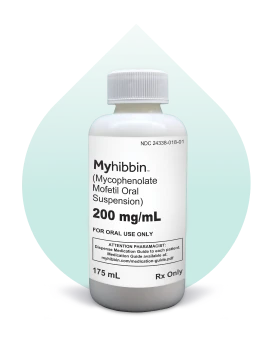
Myhibbin is a molecule you know and trust in a ready-to-use formulation1-3,a
aMyhibbin must be shaken before administering.
Mycophenolate mofetil has been a vital part of transplant maintenance therapy for nearly 30 years.1,2
Every year, there are about 40,000 kidney, liver, and heart transplants.4
For most transplant patients, mycophenolate mofetil becomes a vital part of their maintenance therapy regimen.1
It’s not uncommon for patients to have difficulty swallowing pills. In fact, it’s reported that 70% of children, 30% of adolescents, and 37% of adults have difficulty swallowing tablets or capsules.5-7

NDC: 24338-018-01
Dye-free raspberry-flavored liquid.2,8
Familiar 200 mg/mL concentration.2,9
Pharmacist Recommendation Series: Myhibbin
In this video, clinical pharmacists Tammie Lee Demler and Amanda Yee discuss the benefits and risks of ready-to-use liquid Myhibbin
Reconstituting mycophenolate mofetil can be hazardous
Reduced Risk

Other mycophenolate oral suspensions must be reconstituted by a pharmacist, which may generate dangerous dust and lead to potential hazardous exposure.9-11
- ASHP guidelines advise avoiding manipulating hazardous drugs, if possible, to reduce the preparer’s risk of exposure11

Mycophenolate mofetil is a teratogenic NIOSH hazardous drug, so preparers can incur risks to their health, including reproductive harm.9,12
- ~60% of pharmacists are female13
- Are there circumstances where patients mix at home?b Anyone is at risk of exposure who prepares or handles mycophenolate powder9-11

Despite best practices in the workplace, there’s still a risk of exposure.14
- One study assessing airborne exposure in the pharmacy reported that when pharmacists perform handling tasks as a full-time job, reconstitution of hazardous drugs results in a high risk of exposure, even when working with a dust exhaust, and additional protective measures are required15
Nixing the mix reduces pharmacists’ risk of exposure to mycophenolate powder because it doesn’t require preparation.2,10
bOral suspension mycophenolate powder must be reconstituted by the pharmacist prior to dispensing to the patient.9
Myhibbin: reliable, consistent, ready-to-use2
Accurate Formulation
Myhibbin’s ready-to-use formulation reduces the chance of medication errors.16
- ASHP guidelines note that medication errors are common and costly, due in part to the lack of available RTU medication forms17
Myhibbin provides the same consistent concentration in every bottle, for a formulation you can rely on.2

Myhibbin delivers mycophenolate in a dye-free raspberry-flavored liquid.2,8
It's the right time for a ready-to-use
Time-Saving
The fastest preparation is no preparation.
Without the additional safety precautions required to prepare other oral solutions, pharmacists may save valuable time.18,c

double chemotherapy gloves

ventilated engineering control

protective gown

respiratory protection and eye/face protection
cMycophenolate mofetil has demonstrated teratogenic effects in humans. Wearing disposable gloves is recommended when wiping the outer surface of the Myhibbin bottle and/or bottle cap.2
Avoid direct contact of Myhibbin with skin or mucous membranes.2
Pharmacists can conveniently request a change in mycophenolate mofetil therapy to Myhibbin with this downloadable form.
Download Now
Actor Portrayal
Nix the mix with Myhibbin.
Get ready for the only ready-to-use oral suspension mycophenolate.3
Ask for it by name.
IMPORTANT SAFETY INFORMATION
INDICATION
- MYHIBBINTM (mycophenolate mofetil oral suspension) is an antimetabolite immunosuppressant indicated for the prophylaxis of organ rejection in adult and pediatric recipients 3 months of age and older of allogeneic kidney, heart, or liver transplants, in combination with other immunosuppressants.
WARNING: EMBRYOFETAL TOXICITY, MALIGNANCIES, and SERIOUS INFECTIONS
- Use during pregnancy is associated with increased risks of first trimester pregnancy loss and congenital malformations. Avoid if safer treatment options are available. Females of reproductive potential must be counseled regarding pregnancy prevention and planning [see Warnings and Precautions (5.1), Use in Special Populations (8.1, 8.3)].
- Increased risk of development of lymphoma and other malignancies, particularly of the skin [see Warnings and Precautions (5.2)].
- Increased susceptibility to bacterial, viral, fungal, and protozoal infections, including opportunistic infections and viral reactivation of hepatitis B and C, which may lead to hospitalizations and fatal outcomes [see Warnings and Precautions (5.3)].
Handling and Disposal: Mycophenolate mofetil (MMF) has demonstrated teratogenic effects in humans. Wearing disposable gloves is recommended when wiping the outer surface of the bottle and or the bottle cap. Avoid direct contact of MYHIBBIN with skin or mucous membranes. Follow applicable special handling and disposal procedures according to OSHA Hazardous Drugs. Do not use after 60 days of first opening the bottle.
ADDITIONAL IMPORTANT SAFETY INFORMATION
CONTRAINDICATIONS
Hypersensitivity to mycophenolate mofetil, mycophenolic acid, polysorbate 80, or any other component of the drug product.
WARNINGS AND PRECAUTIONS
Embryofetal Toxicity
Use of MMF during pregnancy is associated with an increased risk of first trimester pregnancy loss and an increased risk of congenital malformations, especially external ear and other facial abnormalities including cleft lip and palate, and anomalies of the distal limbs, heart, esophagus, kidney, and nervous system. Females of reproductive potential must be made aware of these risks and must be counseled regarding pregnancy prevention and planning. Avoid use of MYHIBBIN during pregnancy if safer treatment options are available.
Lymphoma and Other Malignancies
Patients receiving immunosuppressants, including MYHIBBIN, are at increased risk of developing lymphomas and other malignancies, particularly of the skin. The risk appears to be related to the intensity and duration of immunosuppression rather than to the use of any specific agent. For patients with increased risk for skin cancer, exposure to sunlight and UV light should be limited by wearing protective clothing and using a broad-spectrum sunscreen with a high protection factor.
Post-transplant lymphoproliferative disorder (PTLD) developed in 0.4% to 1% of patients receiving MMF (2 g or 3 g) with other immunosuppressive agents in controlled clinical trials of kidney, heart, and liver transplant patients. The majority of PTLD cases appear to be related to Epstein-Barr Virus (EBV) infection. The risk of PTLD appears greatest in those individuals who are EBV seronegative, a population which includes many young children. In pediatric patients, no other malignancies besides PTLD were observed in clinical trials.
Serious Infections
Patients receiving immunosuppressants, including MYHIBBIN, are at increased risk of developing bacterial, fungal, protozoal, and new or reactivated viral infections, including opportunistic infections. The risk increases with the total immunosuppressive load. These infections may lead to serious outcomes,including hospitalizations and death.
Consider dose reduction or discontinuation of MYHIBBIN in patients who develop new infections or reactivate viral infections, weighing the risk that reduced immunosuppression represents to the functioning allograft.
Blood Dyscrasias: Neutropenia and Pure Red Cell Aplasia (PRCA)
Severe neutropenia [absolute neutrophil count (ANC) <0.5 x 103/µL] developed in transplant patients receiving MMF 3 g daily. Patients receiving MYHIBBIN should be monitored for neutropenia. Neutropenia has been observed most frequently in the period from 31 to 180 days post-transplant in patients treated for prevention of kidney, heart, and liver rejection. The development of neutropenia may be related to MYHIBBIN itself, concomitant medications, viral infections, or a combination of these causes. If neutropenia develops (ANC <1.3 x 103/µL), dosing with MYHIBBIN should be interrupted or the dose reduced, appropriate diagnostic tests performed, and the patient managed appropriately.
Consider monitoring with complete blood counts weekly for the first month, twice monthly for the second and third months, and monthly for the remainder of the first year.
Gastrointestinal Complications
Gastrointestinal bleeding requiring hospitalization, ulceration, and perforations were observed in clinical trials. Physicians should be aware of these serious adverse effects particularly when administering MYHIBBIN to patients with a gastrointestinal disease.
Patients With Hypoxanthine-Guanine Phosphoribosyltransferase (HGPRT) Deficiency
Mycophenolate mofetil is an inosine monophosphate dehydrogenase (IMPDH) inhibitor; therefore, it should be avoided in patients with hereditary deficiencies of HGPRT, such as Lesch-Nyhan and Kelley-Seegmiller syndromes, because it may cause an exacerbation of disease symptoms characterizedby the overproduction and accumulation of uric acid leading to symptoms associated with gout, such as acute arthritis, tophi, nephrolithiasis or urolithiasis, and renal disease including renal failure.
Acute Inflammatory Syndrome Associated With Mycophenolate Products
Acute inflammatory syndrome (AIS) has been reported with the use of MMF and mycophenolate products, and some cases have resulted in hospitalization. AIS is a paradoxical pro-inflammatory reaction characterized by fever, arthralgias, arthritis, muscle pain, and elevated inflammatory markers, including C-reactive protein and erythrocyte sedimentation rate, without evidence of infection or underlying disease recurrence. Symptoms occur within weeks to months of initiation of treatment or a dose increase. After discontinuation, improvement of symptoms and inflammatory markers are usually observed within 24 to 48 hours.
Monitor patients for symptoms and laboratory parameters of AIS when starting treatment with mycophenolate products or when increasing the dosage. Discontinue treatment and consider other treatment alternatives based on the risk and benefit for the patient.
Immunizations
During treatment with MYHIBBIN, the use of live attenuated vaccines should be avoided (e.g., intranasal influenza, measles, mumps, rubella, oral polio, BCG, yellow fever, varicella, and TY21a typhoid vaccines) and patients should be advised that vaccinations may be less effective. Advise patients to discuss with a physician before seeking any immunizations.
Blood Donation
Patients should not donate blood during therapy and for at least 6 weeks following discontinuation of MYHIBBIN because their blood or blood products might be administered to a female of reproductive potential or a pregnant woman.
Semen Donation
Based on animal data, men should not donate semen during therapy and for 90 days following discontinuation of MYHIBBIN.
Effect of Concomitant Medications on Mycophenolic Acid Concentrations
A variety of drugs have the potential to alter systemic MPA exposure when co-administered with MYHIBBIN. Therefore, determination of MPA concentrations in plasma before and after making any changes to immunosuppressive therapy, or when adding or discontinuing concomitant medications, may be appropriate to ensure MPA concentrations remain stable.
Potential Impairment of Ability to Drive or Operate Machinery
MYHIBBIN may impact the ability to drive and use machines. Patients should avoid driving or using machines if they experience somnolence, confusion, dizziness, tremors, or hypotension during treatment with MYHIBBIN.
ADVERSE REACTIONS
The most common adverse reactions in clinical trials (≥20%) include diarrhea, leukopenia, infection, and vomiting, and there is evidence of a higher frequency of certain types of infections (e.g., opportunistic infection).
DRUG INTERACTIONS
See full prescribing information for drugs that may interfere with systemic exposure and reduce MYHIBBIN efficacy: antacids with magnesium or aluminum hydroxide, proton pump inhibitors, drugs that interfere with enterohepatic recirculation, telmisartan, calcium-free phosphate binders.
MYHIBBIN may reduce the effectiveness of oral contraceptives. Use of additional barrier contraceptive methods is recommended.
See full prescribing information for other important drug interactions.
USE IN SPECIFIC POPULATIONS
Pregnancy
Use of MMF during pregnancy is associated with an increased risk of first trimester pregnancy loss and an increased risk of multiple congenital malformations in multiple organ systems (see Human Data). Oral administration of mycophenolate to rats and rabbits during the period of organogenesis produced congenital malformations and pregnancy loss at doses less than the recommended clinical dose (0.01 to 0.05 times the recommended clinical doses in kidney and heart transplant patients).
There is a pregnancy exposure registry that monitors pregnancy outcomes in women exposed to mycophenolate during pregnancy and those becoming pregnant within 6 weeks of discontinuing MYHIBBIN treatment. To report a pregnancy or obtain information about the registry, visit the Mycophenolate Pregnancy Registry at www.mycophenolateREMS.com or call 1-800-617-8191.
Females and Males of Reproductive Potential
Females of reproductive potential must be made aware of the increased risk of first trimester pregnancy loss and congenital malformations and must be counseled regarding pregnancy prevention and planning.
Pregnancy Planning
For patients who are considering pregnancy, consider alternative immunosuppressants with less potential for embryofetal toxicity whenever possible. Risks and benefits of MYHIBBIN should be discussed with the patient.
Pregnancy Testing
To prevent unplanned exposure during pregnancy, all females of reproductive potential should have a serum or urine pregnancy test with a sensitivity of at least 25 mlU/mL immediately before starting MYHIBBIN. Another pregnancy test with the same sensitivity should be done 8 to 10 days later. Repeat pregnancy tests should be performed during routine follow-up visits. Results of all pregnancy tests should be discussed with the patient. In the event of a positive pregnancy test, consider alternative immunosuppressants with less potential for embryofetal toxicity whenever possible.
Contraception
Female Patients
Females of reproductive potential taking MYHIBBIN must receive contraceptive counseling and use acceptable contraception. Patients must use acceptable birth control during the entire MYHIBBIN therapy, and for 6 weeks after stopping MYHIBBIN, unless the patient chooses abstinence.
Patients should be aware that MYHIBBIN reduces blood levels of the hormones from the oral contraceptive pill and could theoretically reduce its effectiveness.
Male Patients
Genotoxic effects have been observed in animal studies at exposures exceeding the human therapeutic exposures by approximately 1.25 times. Thus, the risk of genotoxic effects on sperm cells cannot be excluded. Based on this potential risk, sexually active male patients and/or their female partners are recommended to use effective contraception during treatment of the male patient and for at least 90 days after cessation of treatment. Also, based on the potential risk of genotoxic effects, male patients should not donate sperm during treatment with MYHIBBIN and for at least 90 days after cessation of treatment.
The Important Safety Information does not include all the information needed to use MYHIBBIN safely and effectively. Please see the full Prescribing Information for MYHIBBIN.
To Report SUSPECTED ADVERSE REACTIONS, contact Azurity Pharmaceuticals, Inc. at 1-800-461-7449, or FDA at 1-800-FDA-1088 or www.fda.gov/MedWatch.
© 2024 Azurity Pharmaceuticals, Inc.
PP-MYH-US-0008
References: 1. Nelson J, Alvey N, Bowman L. Consensus recommendations for use of maintenance immunosuppression in solid organ transplantation: endorsed by the American College of Clinical Pharmacy, American Society of Transplantation, and the International Society for Heart and Lung Transplantation. Pharmacotherapy. 2022;42(8):599-603. 2. MYHIBBIN [prescribing information]: Woburn, MA: Azurity Pharmaceuticals, Inc; 2024. 3. Approved drug products with therapeutic equivalence evaluations: Orange Book. US Food and Drug Administration website. Accessed May 19, 2025. https://www.fda.gov/drugs/drug-approvals-and-databases/approved-drug- products-therapeutic-equivalence-evaluations-orange-book 4. US Department of health and Human Services. Organ Procurement & Transplantation Network. National Data. Accessed March 19, 2025. https://optn.transplant.hrsa.gov/data/view-data-reports/ national-data/ 5. Tomlin S, Wright D. How to help if a patient can’t swallow. The Pharmaceutical Journal website. Accessed March 19, 2025. https://pharmaceutical-journal.com/article/ld/how-to-help-if-a-patient-cant-swallow 6. Polaha J, Dalton WT III, Lancaster BM. Parental report of medication acceptance among youth: implications for everyday practice. South J Med. 2008;101(11):1106-1112. 7. Schiele JT, Quinzler R, Klimm HD, Pruszydlo MG, Haefeli WE. Difficulties swallowing solid oral dosage forms in general practice population: prevalence, causes, and relationship to dosage forms. Eur J Clin Pharmacol. 2013;69:937-948. 8. Data on file. Azurity Pharmaceuticals, Inc. 9. CellCept [package insert]: South San Francisco, CA: Genentech USA, Inc.; 2022. 10. USP General Chapter <800> Hazardous drugs–handling in healthcare settings. July 1, 2020. 11. Power LA, Coyne JW. ASHP guidelines on handling hazardous drugs. Am J Health-Syst Pharm. 2018;75:1996-2031. 12. NIOSH List of Hazardous Drugs in Healthcare Settings, 2024. U.S. Centers for Disease Control and Prevention; National Institute for Occupational Safety and Health. Publication Number 2025-103 (Supersedes 2016-161). Accessed 19, 2025. https://www.cdc.gov/niosh/docs/2025-103/default.html 13. Labor force statistics from the current population survey. United States Department of Labor website. Accessed March 19, 2025. https://www.bls.gov/cps/ 14. Connor TH, Lawson CC, Polovich M, McDiarmid MA; Department of Health and Human Services, Centers for Disease Control & Prevention; National Institute for Occupational Safety and Health. Reproductive Risks Associated With Hazardous Drug Exposures in Healthcare Workers and Recommendations for Reducing Exposures. Accessed March 19, 2025. Publication number 2012-XXX. 15. Crul M, Breukels O, Ng S, et al. Limited health risks in performing drug reconstitution and handling tasks in pharmacies—results of an occupational risk assessment study. JOEM. 2023;65(4):e204-e210. 16. Billstein-Leber M, Carillo JD, Cassano AT, Moline K, Robertson JJ. ASHP guidelines on preventing medication errors in hospitals. Am J Health-Syst Pharm. 2018;75(19):1493-1517. 17. Eiland LS, Benner K, Gumpper KF, et al. ASHP-PPAG guidelines for providing pediatric pharmacy services in hospitals and health systems. J Pediatr Pharmacol Ther. 2018;23(3)177-191. 18. The Centers for Disease Control and Prevention. The National Institute for Occupational Safety and Health. Managing Hazardous Drug Exposures: Information for Healthcare Settings. Published April 2023. Accessed March 20, 2025. https://www.cdc.gov/niosh/docs/2023-130/2023-130.pdf?id=10.26616/NIOSHPUB2023130